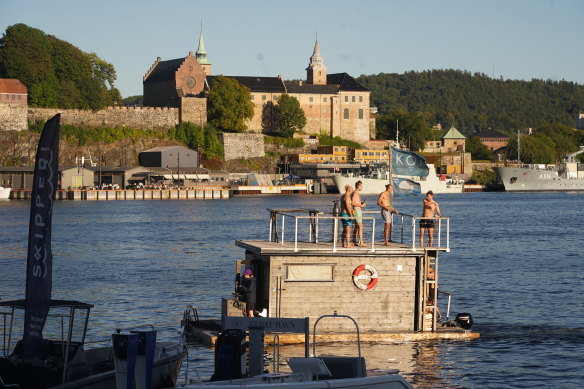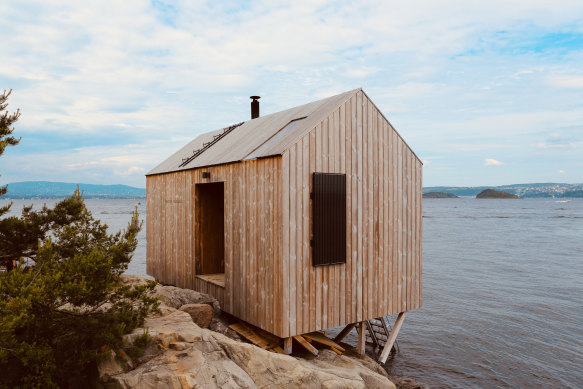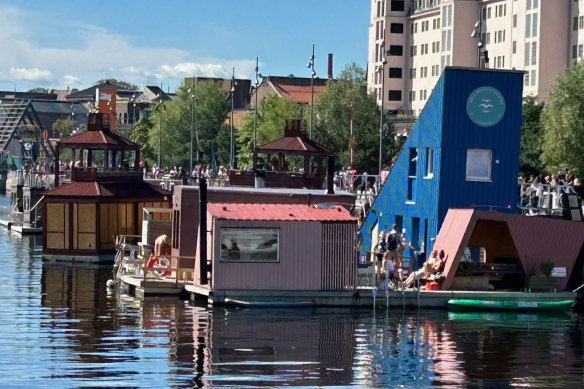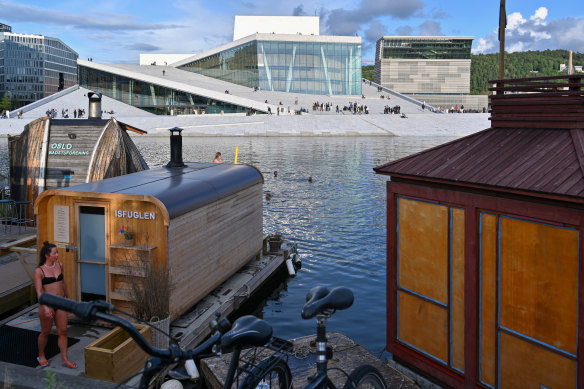Why you shouldn’t miss Oslo’s most masochistic pastime
By Julie Lewis
I spent my 31st birthday running through the snow in Tatarstan in the heart of Russia after sweating inside a tiny timber sauna built at the back of a frozen field. A handful of other women from an upcoming wedding had sweated alongside me and the sauna experience included being whipped with a birch branch slightly more forcefully than necessary by an angsty mother-in-law-to-be.
Though that moment stands out, I regularly went to the sauna, or banya, while I lived in Russia and am fond of the dopamine-inducing delights of the northern hemisphere’s most masochistic past-time. Centuries before Wim Hof began touting the health benefits of ice baths, the people of the planet’s snowy north knew that voluntarily subjecting the human body to temperature extremes felt good – once you got over the initial teeth (and buttock) clenching shock.

A motorised floating sauna in Oslo passes in front of the Akershaus Fortress .Credit: Michael Carey
So when a colleague heard I was going to Scandinavia and recommended taking a sauna in his former hometown of Copenhagen, I was enthusiastic. Especially when I looked at the sauna he suggested: La Bachina, a small, rustic enterprise where the traditional intermittent cool-down was not a Russian-countryside run in the snow or Moscow-style dip in a freezing indoor pool but a dive into the Copenhagen harbour with the sky overhead and city waterfront vista before you. He recommended the sunrise sauna. But I left my booking too late and none of my wait-list bookings came through. I left the city still in need of the kind of invigorating buzz only a sauna can give.
In Oslo, it proved easier. Like Copenhagen, Oslo has been cleaning up its harbour and numerous floating saunas have sprung up along the waterfront, offering plenty of choice, from those that seem more like nightclubs with sauna on the side to ramshackle timber shacks wafting wood-smoke over the water.
Now, having visited the city, I’ve got a better sense of the scene and, if I was staying longer, I’d try the saunas alongside the upmarket Aker Brygge area opposite the Akershaus Fortress for the view of the fortress and the harbour. And I’d leap at the chance to try a motorised sauna, which can take you further out into the Oslo fjord.

A wooden sauna on the edge of the coast in Nesodden, Norway. Credit: Getty Images
But because I was unfamiliar with Oslo I reserved a spot for my husband and me with the Oslo Badstuforening, or Sauna Association, a volunteer group that was instrumental in getting Oslo to sprinkle its newly de-industrialised shorelines with sauna, and runs various styles of sauna in different locations. They seemed affordable and low-key, offering everything from multisensory rituals to a traditional shared naked sauna. I thought my husband would draw the line at getting his kit off among strangers so I booked a clothed, shared sauna at Langkaia, directly opposite Oslo’s famous Opera House. I imagined it would be like taking a sauna in front of the Sydney Opera House but without the risk of being run down by a ferry.
Scandinavians speak impeccable English and most websites have an English translation, so it was easy to book online, and cost 390 NOK ($54). There are two other sauna establishments along the harbour walk in this location so if a view of the spectacular Opera House is what you are after Langkaia is a good, easy-to-access option.
Because my husband hadn’t packed swimmers we took a shopping trip to Oslo’s centre to buy board shorts plus some cheapish towels as the sauna rules stipulate each person needs to bring two - one to dry off with and one to sit on.
As the day dawned bright and blue, I felt nervous knowing I was about to dunk myself in a Scandinavian fjord. But a quick check of the water temperature in Sydney v Oslo calmed me. The water temperature at Bondi was 18 degrees. The late summer temperature in Oslo fjord was 17.4. I’ve probably swum in colder water on the NSW or Victorian south coasts.

The sauna run by the Oslo Badstuforening, or Sauna Association, at Langkaia, Oslo.Credit: Michael Carey
Then a disappointment. When we got to the sauna, a Lego-block-like collection of buildings, a blackboard outside delivered a message familiar to Sydney swimmers. Water quality testing had found that due to recent heavy rains the quality of the water was poor, and the sauna advised customers not to swim in it. I quizzed our sauna staff member about it: say it wasn’t so. It was true, she confirmed, the advice was not to swim. But, she told us brightly, they had very good, very cold showers that delivered the same effect. She must have seen my facial expression shape itself into something like that of Edvard Munch’s famous Scream, which hangs at the towering Munch Museum just across from the sauna. Part of the attraction was a fjord dip. Reluctantly she conceded, you could swim, but not if you had open cuts. And don’t put your head underwater.
We went to change into our swimmers, mulling our options. I asked a couple of Norwegian women in my change room what they had done. Showered, they said. But as long as you don’t put your head under, a swim could be ok. They weren’t particularly encouraging. I tiptoed to the edge of the sauna, with the bone-white Opera House looming like an iceberg directly opposite. I could see bird feathers, a bit of plastic wrapping, leaves. Certainly, not pristine. Maybe I would try the showers after all.
We opened the door to the sauna and a wall of heat hit us. It was quite busy. Two American girls had prime position by the windows that looked up the bay towards the open harbour – a glorious scene of water and sky and a distant shore, some boats at the wharf close to us. A Scandinavian mum and her young son were on a lower bench. Next to us a Norwegian man was holding court introducing some American friends to the joys of sauna. They included a visiting musician from Memphis.

Saunas cling to the foreshore facing Oslo’s Opera House and the Munch Museum to its right. Credit: Getty Images
The Norwegian was extolling not only the mood-lifting effects of the neurotransmitter hit sauna gives but also its health benefits, from building muscle to boosting immunity. I can’t vouch for how scientifically accurate he was, but I do know the relaxed sauna vibe was conducive to human connection, and that’s got to be healthy. We had an easy conversation with him about where he came from (the west coast, which made him, in his words, a Norwegian bogan), his school friend who now lives in Australia on a farm and drives quad bikes, and the secret to the Norwegians’ excellent English (watching soap operas and listening to pop music – in addition to good schooling). I was happy to discover that birch whipping doesn’t seem to be a thing in Norway. We sat there gently roasting and letting sweat prickle over the surface of our skin.
The American girls had braved the fjord, keeping their heads above water, the Scandinavian mum had used the shower. What to do? In the end I just couldn’t pass up the fjord and gingerly lowered myself down a ladder into the water. A bracing chill hit me. I swam out beyond the bits of city muck to where the water was clear and admired the angular Opera House to my left, built to be walked on, distantly dotted with tourists. The foreshore was busy, but a blue sky stretched out above the fjord ahead of me. It was serene. Then I heard a yelp. It was my husband getting into the water – and quickly out. Too cold for him. I did another two rounds of heat and harbour, always keeping my head out of the water.
Our Norwegian friend was adamant that to get the true benefits of sauna in Oslo, we had to try it in winter when the water was full of floating ice. But after we showered, dressed and strolled back through the streets of Oslo to our Airbnb, we both felt magically mellow; even in summer a sauna in Oslo is sensational and not to be missed if you are in the city. Best of all, I didn’t get sick afterwards, so I’m glad I took the risk to swim. It was an unforgettable experience, urban, different to running around the backblocks of Russia, but just as vivid.
Sign up for the Traveller Deals newsletter
Get exclusive travel deals delivered straight to your inbox. Sign up now.